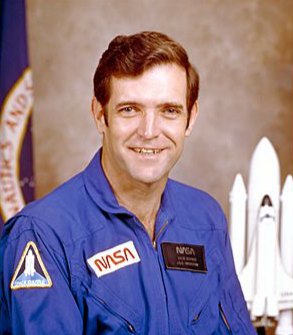Dick Scobee (Francis Richard Scobee)

Dick Scobee enlisted in the United States Air Force in 1957, where he served as a reciprocating engine mechanic at Kelly Air Force Base in San Antonio, Texas. While off duty, he attended San Antonio College, and eventually received a Bachelor of Science degree in Aerospace Engineering from the University of Arizona in 1965. He was a member of Tau Beta Pi. In 1965, he was awarded an officer’s commission. Afterward, he attended flight school and earned his pilot wings in 1966, serving as a combat aviator in the Vietnam War. He was awarded the Distinguished Flying Cross, the Air Medal, and other decorations. After his tour of duty, Scobee attended the USAF Aerospace Research Pilot School at Edwards Air Force Base, 100 miles north of Los Angeles, California. Upon graduation in 1972, he became an Air Force test pilot, logging thousands of hours of flight time in dozens of aircraft, including the Boeing 747, the experimental X-24B lifting body, the F-111 Aardvark, and the gigantic C-5 Galaxy. Selected for NASA Astronaut Corps in January 1978, Scobee completed his training in August 1979. While awaiting his first orbital spaceflight mission, he served as an instructor pilot for the Shuttle’s 747 carrier aircraft. In April 1984, he piloted Challenger mission STS-41-C, which successfully deployed one satellite and repaired another.
Dick Scobee was assigned Commander for the ill-fated STS-51-L mission. The mission, designed to deploy a satellite to study the approaching Halley’s Comet and to inaugurate the Teacher in Space Project, was delayed numerous times due to bad weather and technical glitches. When the mission finally did lift off the pad, an O-ring seal failure destroyed the shuttle 73 seconds into the flight, killing him and the other six crew members; the disaster, viewed live on national television, prompted several days of national mourning, as well as a major shakeup at NASA. He died a Lieutenant colonel. At T+68 into the mission, the CAPCOM Richard Covey informed the crew that they were “go at throttle up”, and Scobee confirmed the call – his last recorded words were his response, “Roger, go at throttle up.” The shuttle broke up 73 seconds into the flight, and at an altitude of 48,000 feet (14.6 km). Some experts, including one of NASA’s lead investigators, Robert Overmyer, who was closest to Scobee, believed most if not all of the crew were alive and possibly conscious during the entire descent until impact with the ocean. After the investigation, Overmyer stated, “I not only flew with Dick Scobee, we owned a plane together, and I know Scob did everything he could to save his crew. Scob fought for any and every edge to survive. He flew that ship without wings all the way down.”
Born
- May, 19, 1939
- USA
- Cie Elum, Washington
Died
- January, 28, 1986
- USA
- Cape Canaveral, Florida
Cause of Death
- Challenger explosion
Cemetery
- Arlington National Cemetery
- Arlington, Virginia
- USA



